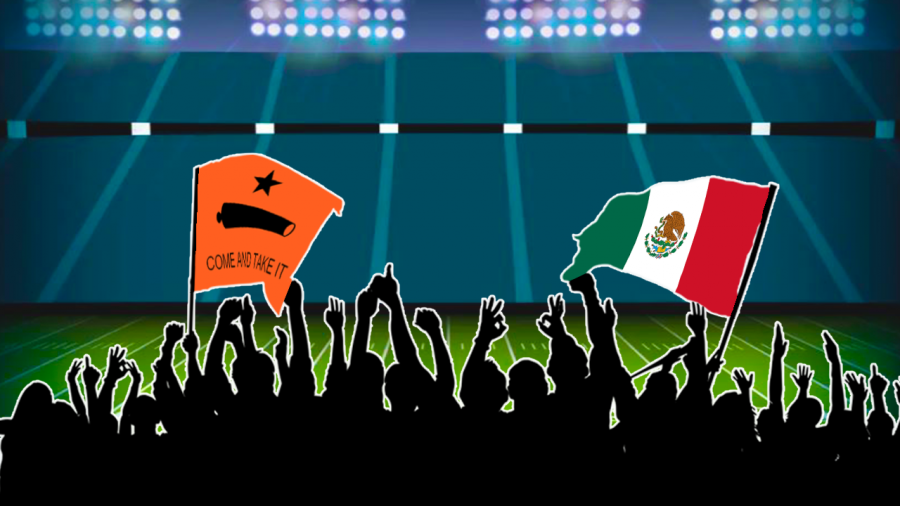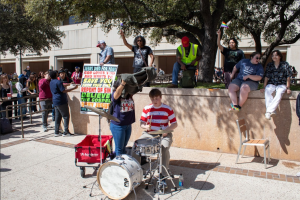Point/Counterpoint: two perspectives on the removal of the ‘Come and Take It’ flag
The debate over the Come and Take It flag’s subsequent removal from UTSA’s campus has elicited strong emotions. What new tradition the university replaces it with will be interesting. Caleb Preston/The Paisano
September 14, 2021
Editor’s Note:
The following point/counterpoint is a composite of opinions from the sports staff, representing a broad range of opinions in favor of the change and against it.
The removal of ‘Come and Take It’ is for the best
Last week on Sept. 7, UTSA President Taylor Eighmy announced in an email distributed to all students that the university would be discontinuing the use of the “Come and Take It” flag during UTSA home football games and additionally, would discontinue the use of the slogan from other areas of the university. The move comes after the university announced it was examining the use of the flag and phrase after concerns about it were raised following the unveiling of the RACE building: where the “Come and Take It” logo is displayed prominently in the lobby. Furthermore, Eighmy announced that the process has begun to craft a new tradition that will replace the “Come and Take It” flag at UTSA football games starting in the 2022 season.
While Eighmy has taken a lot of flak for the move from both donors and the UT Board of Regents, this action is for the best of the university. For starters, the tradition has not been around very long. While a very vocal portion of the fanbase alleges that the “Come and Take It” flag is an integral part of the university’s traditions and identity, it is important to realize just how recently the tradition was adopted. While it was first proposed in 2011, the tradition has only been formally used by UTSA Athletics since 2016: that’s just five years. The “Come and Take It” flag is not the equivalent of dotting the I at Ohio State, or the “Play Like A Champion Today” sign at Notre Dame; this is a tradition that is by no means so systematically intertwined with the football program.
Furthermore, UTSA is a very diverse school and inclusion is a key part of our message. Like it or not, the phrase “Come and Take It” has been co-opted by a number of movements and organizations that do not reflect that inclusive, diverse environment that UTSA holds dear. UTSA has all the momentum in the world right now. The rapid progress of the football program under Coach Traylor, our new athletics facility and the other numerous improvements to athletics facilities in the planning stages, are gaining us national attention and recruiting clout. The last thing UTSA needs right now is a distraction and controversy. President Eighmy did the right thing; he got out in front of a controversy before it consumed the university and became a bigger problem.
However, not everyone saw it that way. In a prepared statement, Kevin Eltife, the chairman of the UT System Board of Regents stated, “I am very disappointed with this decision and will immediately ask our Board to establish policies that ensure that the governing body of the UT system will have the opportunity in the future to be consulted before important university traditions and observances are changed.” It should not be any surprise that the board would have much rather have seen UTSA handle this brewing controversy like the University of Texas did during their handling of “The Eyes of Texas.” Commission a task force, stall for a few months, say nothing is wrong and expect everyone to sit down and be quiet. Instead, President Eighmy showed a steadfast determination to improve the image of his university to the benefit of everyone, even those who do not traditionally have a voice. Beyond image, he put action where his mouth is about UTSA’s devotion to inclusion and acknowledged role as a Hispanic Serving Institution.
This development is a positive one for the university. We do not have time as a rising institution to get bogged down in a fight over a tradition that isn’t a huge part of our university to begin with. We will move forward with an even better tradition than what came before, but the last thing we should do is direct our fury toward a man that has been instrumental in engineering UTSA Athletics’ rise to prominence.
President Eighmy, ‘Come and Take It’
It is never noble to bend to the will of few rather than stand with the support of many.
On Tuesday, Sept. 7, UTSA President Taylor Eighmy released an email statement declaring the end of the university’s affiliation with “Come and Take It.” Eighmy’s decision was immediately met with negative feedback from students, fans, alumni and donors.
Following the opening of the new $41.1 million athletics building, the Roadrunner Athletics Center of Excellence (RACE), a professor began a petition that received less than 350 signatures to remove the slogan from the university.
According to Eighmy, this slogan has been “UTSA’s six-year-old tradition of using the “Come and Take It” phrase and flag as a rallying cry at home football games.” Why only after the viewing of the sign in the lobby of the RACE facility depicting the flag is this an issue? Why were eyebrows not raised at the inception of the flag adaptation six years ago? Why were petitions now assembled instead of when, according to Eighmy’s email, “the Mayor of Gonzales was invited to attend the Oklahoma State game and ran on the field with a smaller “Come and Take It” flag”?
The origin of the slogan dates back to Greek culture when King Leonidas of Sparta refused to surrender to the Persian forces under Xerxes at the battle of Thermopylae in 480 BC. The Spartan forces used the phrase “Molon Labe,” which translates from Greek to “Come and Take It.”
The slogan was used in 1778 in the American Revolution in the Georgia battle at Fort Morris. When the garrison was surrounded by 500 British soldiers, the militia and citizens, which made a force of less than 200, replied, “Come and Take It.”
The defiant slogan of outnumbered men taking a stand was then used at the Battle of Gonzales. According to the Handbook of Texas History, Moses Austin brought 300 Anglo families to settle in Texas after receiving commission from the Spanish governor of Texas. Antonio Lopez de Santa Anna was then elected to head the Mexican government, but he changed his allegiance in 1835 from federalist to a centralist government and assumed absolute power.
During the Battle of Gonzales, the Mexican government was attempting to reclaim the cannon given to the citizens of the town to protect themselves against Native American raids. The townspeople and militia gathered, raising the flag stating “Come and Take It.” The Handbook of Texas History states, “With the fight at Gonzales, Texians, along with a sizeable number of Tejanos — prepared for war.” The Texas State Historical Association accounts that about 3,700 men joined to fight for Texas independence. With only 300 Anglo families in the territory, a majority of the men fighting were native Mexican citizens. How can the “Come and Take It” flag be labeled Anti-Hispanic when most participants in the defiance of the Mexican government were Mexican citizens?
If the professors who began the petition had truly had an issue with the slogan, the fight would have begun six years ago when the flag was brought to represent the university, not after the athletics department had spent millions of dollars erecting a new facility. Following the email, many high-paying athletics donors publicly stated they would be reconsidering their contributions to UTSA in the future. UTSA will have to spend more time erasing signage on walls, buildings, fields, merchandising and uniforms than it took 333 people to sign a petition.
The football team’s slogan this season is “do not eat the cheese.” It seems the dairy section is President Eighmy’s favorite aisle. “Come and Take It.”








